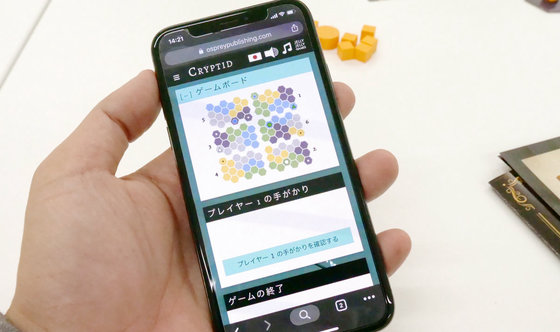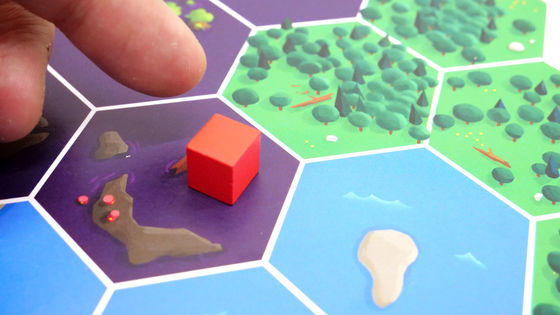A logic battle game `` cryptid '' play review to discover unidentified animals before anyone with only a few clues and inferences

Logical reasoning game 'cryptid' – JELLY JELLY GAMES
https://jelly2games.com/cryptid
Crypted's package depicts unidentified creatures, such as the serpents that emerged from deep fog, somewhat reminiscent of a monster panic movie poster.

The left side is designed like the spine of an old Western book, so it doesn't seem strange to store it in a bookshelf. For Cryptid, the target age is 10 years or older, the playing time is 30 to 50 minutes, and the number of players is set to 2 to 5 people.

When you opened the lid, your eyes jumped to the rule book with a cover like a magic book that tells about the existence of an older and more terrifying monster.

Monster silhouette in the center.

Other than the instructions, there were five colors of 'Literature', each with a Greek letter from α to ε on the cover.

Map tile composed of hexagonal cells. There are five types of trout: forest (green), waterside (blue), desert (yellow), swamp (purple), and mountains (ash).

Since the cardboard has a cut, it can be easily removed without tools.

There are two types of player pieces, disk (cylinder) and cube (cube), for five colors.

Note that the bag containing the tops cannot be sealed once opened. When storing, pieces are spilled out of the box, so it is recommended that you purchase a bag with a zipper that can be subdivided at a 100 yen shop or the like when storing.

There is one black pawn, ruined coma (triangular prism) and megalith coma (octagonal prism), each of four types: blue, black, green, and white.

There are 54 cards in total. One side of the card has the map tiles arranged on it, and the other side has a number corresponding to the document.

There are two types of cards, white cards on both ends are for regular games, and black cards on both ends are for advanced games. It is recommended that you divide the game before you start the game so that you can use the game according to the difficulty of the game.

This time I played with 5 people. First, we will distribute 5 books from α to ε, and player pieces corresponding to each color.

Shuffle the cards well and pick one. This time, I use white cards at both ends to play in a normal game.

Arrange the tiles as drawn on the card and place the megalithic pieces and ruined pieces, and you are ready to go.

Players are scholars looking for unidentified animals in the wilderness of North America. Although everyone is working as a team and cooperative, they have the ambition to be the first discoverer of unidentified animals. Unidentified animals live in only one square of the map tile, and location clues are only one hint from the literature. The purpose of this game is to find out the habitats of unidentified animals by guessing what clues the opponent has, as it is not clear what hints other people get from the literature.
The clues to the literature used in the game are given on the card. For example, in a five-player game, look at the line with '5' at the left end and refer to the number written in the color of each document. For example, in this game, a scholar with an alpha document will get the 66th hint.

When you open the literature, you will find a lot of clues, but only use one. This clue should never be shared with anyone and is a secret hint that only you know.

You can also use the

Once you have the clues in the literature, first place the cubes clockwise from the start player. The cube is a piece placed in a place where you can judge from your own clues that it is 'never a habitat' . For example, a player who has a clue of 'desert or mountain' can place a cube in 'forest, waterside or marsh' that does not meet the habitat conditions. However, there is only one cube per square.

Start the game by placing two cubes per person on two laps.

The way of playing the game is very simple and the start player recommends a turn clockwise. Players can either ' question ' or ' explore ' when it is their turn.
The question is to place a pawn in the trout of interest and nominate one person and ask, 'Is this a habitat?'

The questioned player will place a disc if the pawned cell meets the hint criteria. Unlike cubes, discs are pieces that can only be placed on cells that may have habitats, that is, cells that meet the requirements of your clues .

Of course, if the condition of the hint is not met, place the cube.

When the other player answers the question, the active player also places the cube somewhere on the map tile.

It should be noted that in this game it is OK to mislead your opponent, but you must put the disc and cube honestly. If you make a mistake, you must declare it and correct it immediately.
As each player asks more questions, discs and cubes are placed on the map tiles more and more, 'What kind of clues do your opponents have? ...?' Do you not? ', A suspicion swirls on the table.

Lake where the game progressed and cubes were placed. Instead of being disappointed that 'unidentified animals do not live in this lake ...', it is important to think about why your opponent placed the cube in this lake and infer clues of others.

On the back of each document, the types of clues described in the documents are covered, and while looking at this list, it is inferred that 'the clue held by the other party may be xx ...'.

For example, if you look at the box 1 in the following situation, there are three red disks of the player with the document of α in the desert square. Therefore, other players can infer that, in the literature of α, is desert trout a clue ...? However, in the frame of 2, the red cube is placed on the desert square, so this reasoning is wrong. Furthermore, looking at the frame of 3, the cube is placed away from the waterside, so it can be predicted that 'possibly the clue of the document of α may be' within 1 cell from the waterside cell ''.

Of course, the reasoning can be wrong, so it is important to carefully prove the reasoning in yourself by analyzing more information and asking more questions. When your guess turns into a belief that 'unidentified animals live here!', Explore . Place a pawn and a disc in the square that is here and declare a search.

Place a disk or cube clockwise from the player. As discs are being placed more and more, I'm thrilled to say, 'An unidentified animal has lived here! I'm the first discoverer!'

The search failed because when someone placed the cube, it was determined that there were no unidentified animals in the trout. Place your cube somewhere on the map tile and your turn ends.

As a result of the search, if all the players have placed the discs, the player has successfully searched for 'has found an unidentified animal habitat!' And wins the game.

Next, I played an advanced game with 5 people. Use cards with black ends.

In advanced games, more types of ruins and megaliths are placed on map tiles.

Another major feature of advanced games is that the clues include a negative sentence that says 'not ...' and become more complicated. For example, a clue that 'is not within 3 squares of a green building' means that there is 'absolutely no unidentified animal inhabiting' within 3 squares of a green ruined coma or megalithic coma.

The following situation is where the player placed the purple cube in the document of ε. If you look closely, all three cubes are located within three squares of the black megalith, so you may have a clue that it is ' not within three squares of the black structure.'

In fact, the purple disk is located at the waterside cell more than 4 cells away from the black structure. However, you can also think, 'Is the clue of the player holding the document of ε a waterside square ...?' The technique of misleading other players depending on how the cube is placed is also very important to hide your cues.

However, if five people try to outsmart their opponents, the board becomes more complicated, making it very difficult to reason. If your guesswork gets stuck and you're out of hand! If you get the consent of all but one player, you can get extra clues. Look at the numbers on the right edge of the card ...

Referencing additional clues in the rules manual may help unravel the intertwining thread.

Cryptid is a very simple game that even a 10-year-old child can fully understand if the rules are the only one, but said, `` Inferring other people's cues from the board, comparing them with your own cues, Is a game of 'finding out', and a considerable brain battle is unfolded. Therefore, the target age is '10 years or older', but it can be said that it is actually difficult for someone who is somewhat used to logical thinking.
However, the pleasure of guessing and twisting your head so hard and guessing the correct answer is tremendous, and it is addictive that makes you want to continue playing, 'Once again! Let's do it again!' Also, after the game, each player talks about his own reasoning, such as 'I guessed this, I asked a question here,' 'I searched here but I failed to read it.' The impression battle was really exciting.
One game is about 40 minutes with 5 players. Because each player's thinking ability makes a big difference in play, it may be better to add a handicap, such as setting a time limit based on the outcome of the game. Also, in a five-player game, your inference and obtained information will be enormous, so if you have a note at hand and write it down and play it, the game progresses smoothly. However, you need to be creative so that others cannot see your notes.
The Japanese version of Cryptid can be ordered at the official mail order site of JELLY JELLY GAMES at 4950 yen including tax.
[Reserved Items] Cryptid (planned to be released on February 13) (with promotion card) / Board game mail order 'JELLY'
https://shop.jellyjellycafe.com/products/detail/1499

Related Posts:







